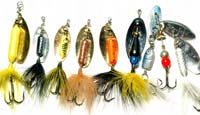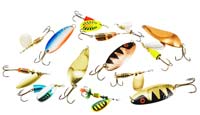Freshwater Salmon Lures
You can use a few different types of salmon lures to successfully catch salmon in freshwater lakes, rivers and streams. Learning about the types of salmon fishing lures, along with the fishing methods associated with each type, can be a very rewarding experience, learn more in this section.
Whether you decide to pursue the spirited steelhead on the Wilson River in Oregon or the mighty king salmon while on a trip to the Great Lakes, there are salmon fishing lures that will help you achieve your angling goals.
While the precise methods and lures most effective for salmon fishing will largely depend on the region, season and species in question, there are a variety of lure types that are believed to be most effective for salmon fishing. You can read additional information on the best fishing lures for salmon to improve your abilities and skills as you gain more experience as an angler.
Lure Color
As you learn about the different types of salmon lures, you will also need to think about which lure colors to use in the waterways where you plan to fish. Keep in mind that when fishing in water up to 50 feet in depth, most colors are visible and acceptable for salmon fishing with the exception of red. The reason for this is that red light is almost completely absorbed within the first 20 to 25 feet of depth. In clear deep water, try using green, blue and purple colors.
Spinners
 If you are fishing in a muddy river or stream, spinners can be very effective salmon lures since the vibrations will help attract the fish when the lures aren't as visible. Spinners have one or more reflective metal blades that spin around to create this vibration as the lure is being reeled in. You can fish spinners using a variety of different retrieve speeds, but you will often experience the best success when you aren't reeling at a fast and furious pace. Retrieving at a slower pace will help keep the spinner closer the bottom of the water column and in the strike zone. If you want to fish for steelhead salmon in a river, a spinner would be a good type of lure to try.
If you are fishing in a muddy river or stream, spinners can be very effective salmon lures since the vibrations will help attract the fish when the lures aren't as visible. Spinners have one or more reflective metal blades that spin around to create this vibration as the lure is being reeled in. You can fish spinners using a variety of different retrieve speeds, but you will often experience the best success when you aren't reeling at a fast and furious pace. Retrieving at a slower pace will help keep the spinner closer the bottom of the water column and in the strike zone. If you want to fish for steelhead salmon in a river, a spinner would be a good type of lure to try.
Plugs
 Plugs are one of the most versatile and effective types of salmon fishing lures. While there are many shapes, colors and sizes of plugs that you can choose from, don't worry. Fishing with plugs doesn't have to be complicated. When river fishing for king salmon, for example, you can try trolling a wobbling, banana-shaped plug for a good chance at a strike. Some anglers even wrap plugs with a piece of sardine, anchovy or herring to make them extra attractive to hungry king salmon. When fishing for salmon in clear shallow waters, consider using rattle and wobble-free plugs that aren’t as likely to spook any fish that are found in these conditions.
Plugs are one of the most versatile and effective types of salmon fishing lures. While there are many shapes, colors and sizes of plugs that you can choose from, don't worry. Fishing with plugs doesn't have to be complicated. When river fishing for king salmon, for example, you can try trolling a wobbling, banana-shaped plug for a good chance at a strike. Some anglers even wrap plugs with a piece of sardine, anchovy or herring to make them extra attractive to hungry king salmon. When fishing for salmon in clear shallow waters, consider using rattle and wobble-free plugs that aren’t as likely to spook any fish that are found in these conditions.
Jigs
 When salmon are found in large schools near a river mouth, you may want to try using a jig. If you aren't sure what size or shape jig to use, do your best to match the hatch. Pay close attention to the baitfish that the salmon are feeding on, and then select a jig that resembles the baitfish in appearance. In addition to size and shape, you will also want to consider the weight of your jig. You should note that large, heavy jigs best when fishing deep water of 50 feet or more for species such as king salmon. Lighter jigs (between 1/3 to 1 ounce) generally work better when targeting coho salmon since this species usually prefers to hang out closer to the surface.
When salmon are found in large schools near a river mouth, you may want to try using a jig. If you aren't sure what size or shape jig to use, do your best to match the hatch. Pay close attention to the baitfish that the salmon are feeding on, and then select a jig that resembles the baitfish in appearance. In addition to size and shape, you will also want to consider the weight of your jig. You should note that large, heavy jigs best when fishing deep water of 50 feet or more for species such as king salmon. Lighter jigs (between 1/3 to 1 ounce) generally work better when targeting coho salmon since this species usually prefers to hang out closer to the surface.
Spoons
 As one of the most versatile freshwater fishing lures, the spoon does a good job of attracting salmon due to the fluttering motion it creates while being trolled or reeled through the water. These lures can be used when fishing for coho salmon from the banks of a river, or can be trolled behind a boat in a large lake or reservoir for king salmon. If you plan to use your boat to troll with a spoon, you may want to use one that has a wobbling, side-to-side action when trolled at a medium to fast speed. When fishing shallow slow-flowing rivers or streams, wider spoons are a good choice since the teardrop shape creates more lift. In deeper areas that have a more rapid flow, use a thinner spoon that will sink in the faster current.
As one of the most versatile freshwater fishing lures, the spoon does a good job of attracting salmon due to the fluttering motion it creates while being trolled or reeled through the water. These lures can be used when fishing for coho salmon from the banks of a river, or can be trolled behind a boat in a large lake or reservoir for king salmon. If you plan to use your boat to troll with a spoon, you may want to use one that has a wobbling, side-to-side action when trolled at a medium to fast speed. When fishing shallow slow-flowing rivers or streams, wider spoons are a good choice since the teardrop shape creates more lift. In deeper areas that have a more rapid flow, use a thinner spoon that will sink in the faster current.
To learn more about other freshwater bait and lures visit our next section.
KEEP LEARNING

First Catch Center Trailer Gallery
FCC Trailer Photo Gallery
LEARN MORE

How to Tie a Duncan Knot
Learn to tie a Duncan knot by following these five simple steps. Watch our new video.
LEARN MORE

Welcome to Angler Academy!
No one said you can’t bring fishing inside! There’s lots of fun activities we can do right from home
LEARN MORE


.png?lang=en-US&ext=.png)